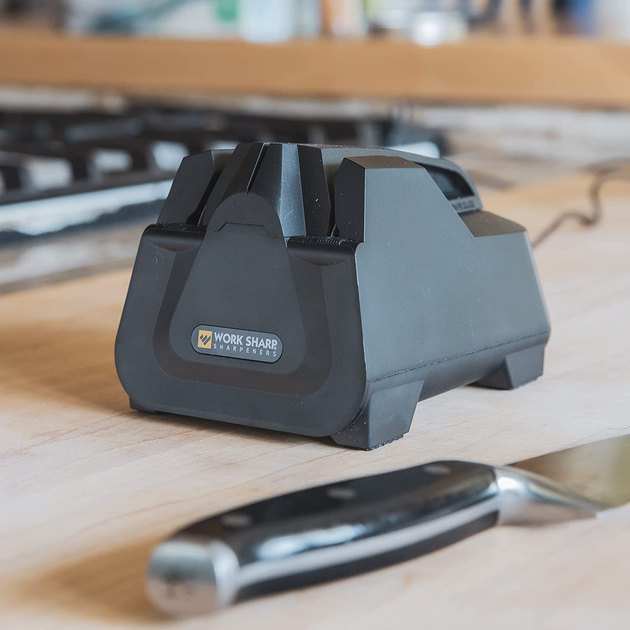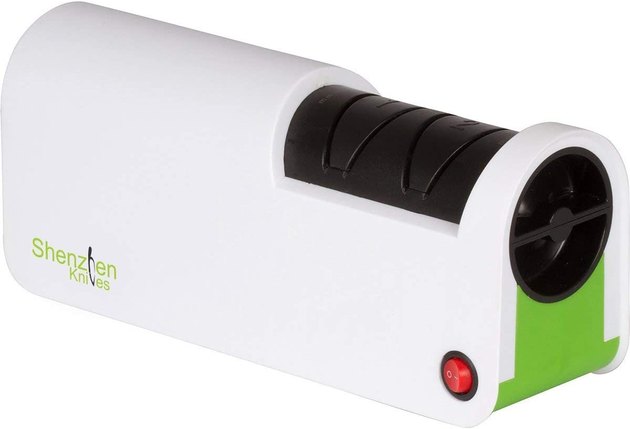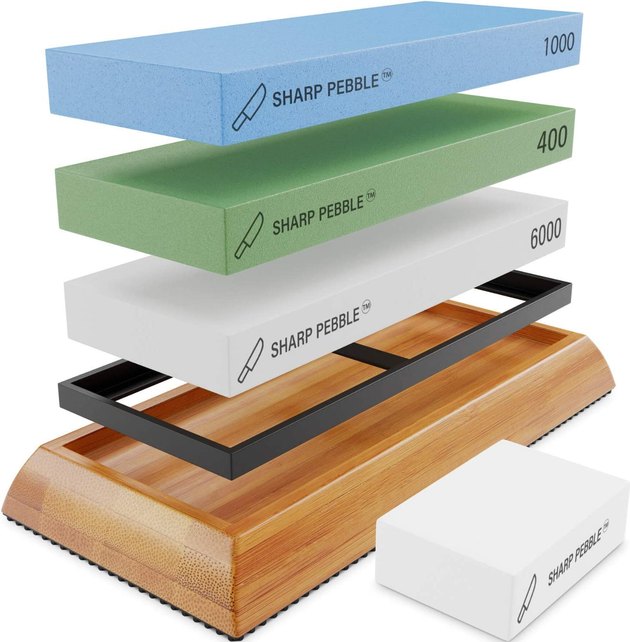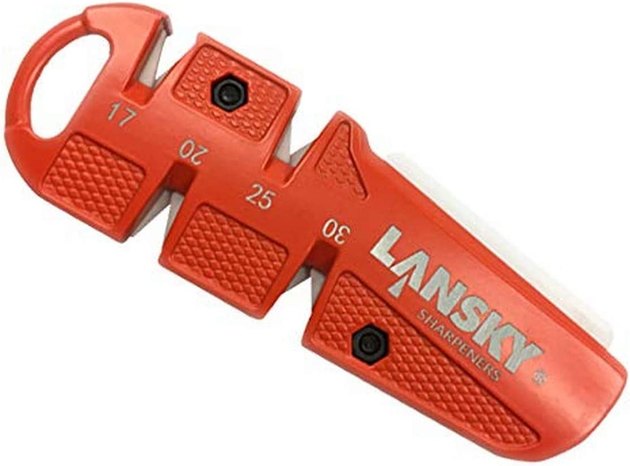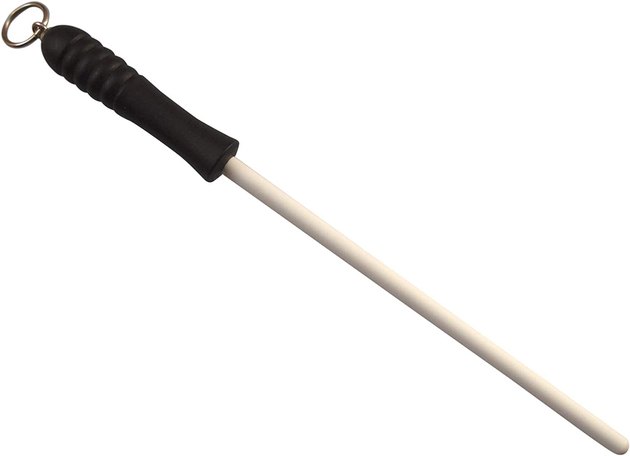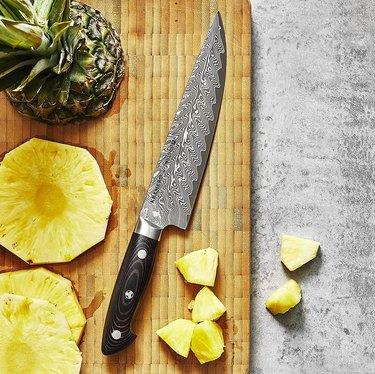
You can buy the best chef knife in the world, but sooner or later it will become unusable if you can't sharpen it. Knife sharpening isn't exactly rocket science, but doing it the traditional way—stroking the blade successively across coarse and fine whetstones, then honing it with a steel—does require both skill and patience. Not all of us have those, and most of us have things we'd rather be doing with our time.
That's why there's a market for knife sharpeners that make the whole process faster and easier. There's one for just about any budget or skill level, so stay tuned while we explain how they work and why we think these are the best knife sharpeners.
Video of the Day
Video of the Day
What to Consider When Purchasing a Knife Sharpener
The first thing to understand is that there are a few stages to the sharpening process. It starts with using a coarser grit to shape the blade's angle and smooth out any nicks or rough spots, and then a finer grit to produce a keen edge. Those thin edges are easily bent, so the final state is to hone the blade on a nearly-smooth surface to straighten them out again (when you see chefs briskly flashing their blades up and down a steel, that's what they're doing).
Some sharpeners give you all three stages, while others give you two levels of sharpening and leave you to do the honing for yourself. Aside from that, there are a few other things you should look at when considering your purchase:
Type of Sharpener: There are several kinds of knife sharpeners, each with its own strengths and weaknesses.
- Whetstones give an excellent edge, but they require skill and patience (if you can't hold the blade at a consistent angle, you won't get an optimal edge).
- Pull-through sharpeners are the easiest for novices to use, but are wildly variable in quality, often give a mediocre edge, and can sometimes damage your blade.
- Electric sharpeners grind the edge with moving stones. They're quick—and good ones do an excellent job—but they remove more metal from your blade than manual sharpeners, and can shorten the lifespan of your knife.
- Pocket sharpeners are good for when you're away from home, whether it's for a road trip, a camping expedition, or just the big family Thanksgiving. They'll put an edge on a neglected blade when you need it, but they're typically not as efficient as regular sharpeners.
Supported Angles: Traditional European knives are made of relatively thick steel, and the blade is sharpened to a 20-degree angle. Japanese knives are typically made of thinner, harder steel, and are sharpened to a finer angle (usually around 15 degrees). Hunting knives are thicker and sturdier and might need a 25-degree angle. The more varied your knife collection, the more you'll appreciate a sharpener that can handle multiple angles.
Ease of Use: Some sharpeners are simple and straightforward to use (hello, pull-through!) while others require some study and set up before you start using them. Your own expectations are key when assessing your individual "sweet spot": If you have department-store knives and just want a quick-and-dirty edge, your priorities will be different from those of a serious enthusiast with a high-cost, high-value collection.

The Best Overall Knife Sharpener
Chef's Choice makes a sharpener called the Trizor XV that regularly wins awards and tops "best of" lists, but it costs quite a bit more than the newer 315 XV. The only difference is that the big unit includes a coarser first stage, meant for rescuing knives that are badly dulled. If you maintain your knives regularly, you'll never use that stage anyway. The smaller 315 XV is otherwise identical to its "big brother," bringing blades to a wickedly fine edge (quickly!) with its diamond-surface abrasive wheels and powerful motor. The spring-loaded guides take the guesswork out of getting the right angle, and it's suitable for use with European or Japanese knives (even single-bevel types, which are sharpened on only one side). It will even do serrated knives. You just can't beat it at the price.
The Best Budget Electric Knife Sharpener
If you want the convenience of a good-quality electric sharpener, but find the 315 XV a bit rich for your blood, The Work Sharp E2 may be what you're looking for. It's not quite as fast or powerful as the Chef's Choice, but its flexible sharpening discs produce a comparable edge and its smaller size makes it much more storage-friendly. On the positive side, this model sharpens just about everything—serrated knives, scissors, kitchen shears, pocketknives—but on the downside, it's only intended to sharpen at the traditional 20-degree bevel. If that works for you, the E2 provides outstanding value for the dollar.
The Best Manual Knife Sharpener
There's a lot to like about pull-through sharpeners. They're inexpensive, they're compact, and they're really easy to use. Unfortunately, their quality varies wildly, with some delivering surprisingly good edges but most offering mediocre performance (and some outright damaging your blades). The best pull-through knife sharpeners often come from top manufacturers, who can migrate tech from their higher-end models. That's the case with this Chef's Choice unit, which brings the company's diamond-coated sharpening surfaces to a lower price point. It can be used left- or right-handed, has a comfortable grip, and offers slots for both 15- and 20-degree bevels. If you want a simple, manual sharpener, this is the one to get.
The Best Knife Sharpener for Ceramic Knives
While most knives are made of steel, a few manufacturers (notably Kyocera) produce ceramic knives. They're popular with a lot of cooks because they're hard and hold their edge for a long time, but most sharpeners won't work with a ceramic blade. In fact, your blade can damage the sharpener! If you favor ceramic blades and want to keep them in top condition, you'll need a sharpener like this one from Shenzhen knives (who, yes, make ceramic knives). The diamond grinding wheels can restore your ceramic knife's edge quickly and easily, and the whole device is surprisingly compact. It will sharpen steel knives as well, though if you're not careful it can quickly remove more steel than you'd like.
The Best Knife Sharpening Stones
If you're serious about your kitchen tools and have put a significant investment into your knives, pull-throughs and powered grinders just won't cut it (sorry). To get the best edges on your pampered blades, and extend their lifespan considerably, you'll need to invest in a set of whetstones like this one (and take the time to learn how to use it). The set includes a 400-grit stone for coarse sharpening, a 1000-grit stone for producing a fine edge—that's where most sets stop—and then a 6000-grit stone, which polishes your blade to a razor-like finish.
The stones are oversized (8 inches long, rather than 6, and extra-thick), which means they're easier to use and longer-lasting than competitive products. The set also includes a flattening stone, for restoring the surfaces of your sharpening stones, and a non-skid bamboo mount so it won't slide around while in use. There are cheaper stones out there—some of them are also of good quality—but this set is genuinely superior, and should last you a lifetime.
The Best Pocket Knife Sharpener
What we said about pull-through sharpeners also applies to pocket sharpeners: The best source is often a manufacturer of higher-end sharpening products. Lansky produces a range of top-quality sharpeners, and this convenient little gadget—about the size of a box cutter—shows its heritage. The four slots use 400-grit ceramics to provide the sharpening power, and one side of the C-Sharp has a finer 800-grit stone built in for refining your edge. The four slots support 17- and 20-degree angles for kitchen knives, and 25- and 30-degree angles for hunting knives and other special-purpose blades. It won't replace your home sharpener, and it's not meant to, but for travel, camping, or occasional use in someone else's kitchen, it's superbly useful.
The Best Honing Rod
It's sadly ironic that the sharper your blade is, the easier it is to damage. Steel bends when it's thin, and the edge on a well-sharpened knife is very thin indeed. You may find your knives are noticeably less keen after just a few uses, but they're not actually dull, as such: The thin edge has just become bent or rippled. Resharpening too often will shorten the life of your blade and it's unnecessary; usually, you just need to hone it a bit. Traditionally you'd do that on a steel, but this ceramic sharpening rod from Idahone is even better. It's got a very fine texture—a grit rating of 1200 to 1500—which means it will tease your edge back to full sharpness much more gently than you would on a steel. If you develop the habit of giving your knife a few strokes on the honing rod before each use, its edge will stay near-perfect for a surprisingly long time.
The Best Knife Sharpening System for Enthusiasts
If you're a serious enthusiast, sinking thousands of dollars into your knife collection, you probably aren't the person to skimp on your sharpening tools either. If that's you (or what you aspire to), then this is your sharpening system. We say "system," because this isn't just a sharpener. It's a full set of stones paired with a sophisticated stand and jig, so you can get a consistently perfect edge on any blade at any angle because it's infinitely adjustable. The Edge Pro consists of a stand, which holds your knife, and an adjustable arm that holds your chosen stone at the correct angle. To sharpen your blade, you just pass the stone across it using the swing arm.
The set comes with stones ranging from 120 grit (really coarse) to 1000 grit, a 1200-grit ceramic hone, and then polishing tapes at 2000 and 3000 grit (which will get you into "shave with it" territory). It takes some time and practice to master, but once you've got the hang of it, you'll be able to sharpen every knife in your collection to an edge that's even better than factory-original.

